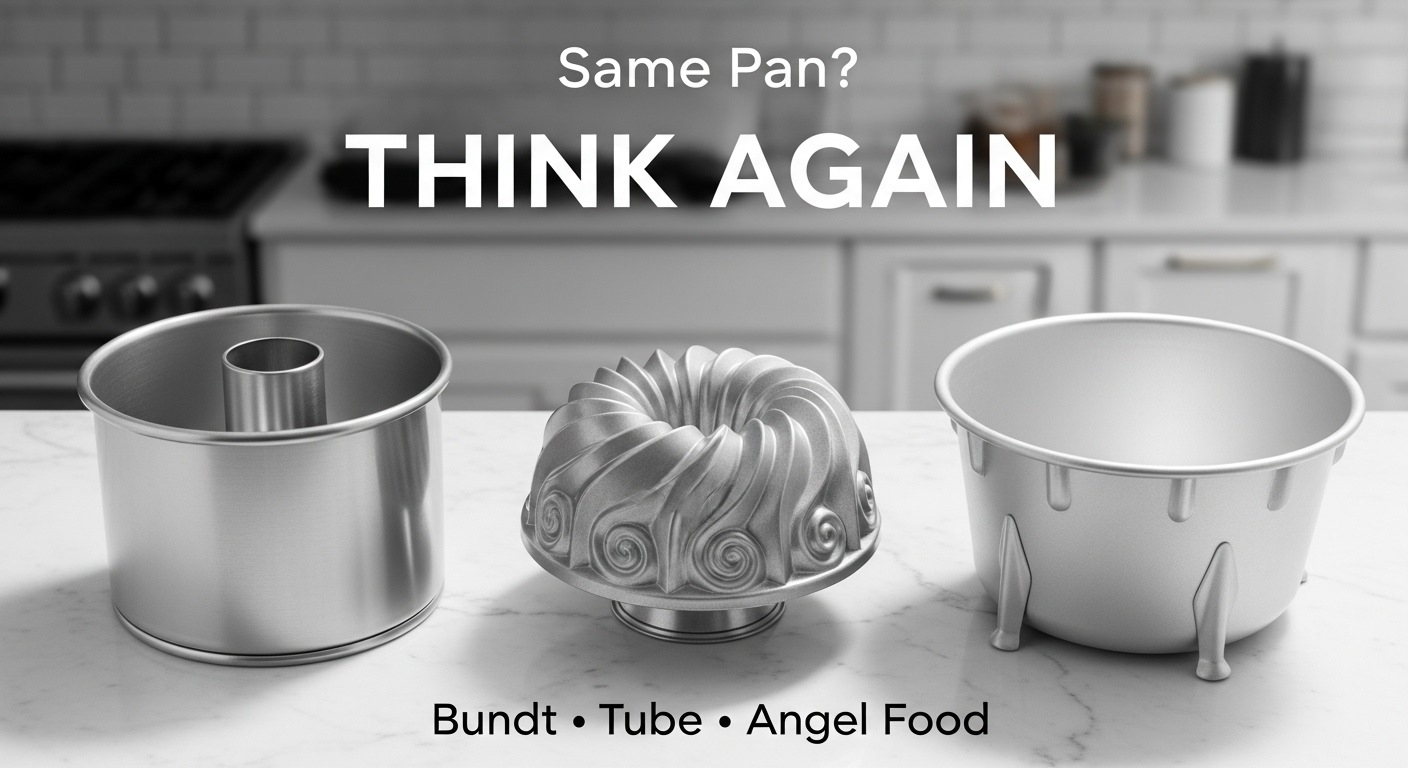
I'll never forget the first time I tried to make an angel food cake in my beautiful Bundt pan. I was so proud of that pan with its gorgeous swirls and ridges, and I figured, "Hey, they both have a hole in the middle, right?" Wrong. So, so wrong.
Three hours later, I was standing in my kitchen with a collapsed cake that refused to come out of the pan, and I learned an expensive lesson: not all pans with tubes are created equal. If you've ever been confused about whether you can swap one for the other, or if you're standing in a kitchen store right now wondering which one to buy, I'm here to save you from making the same mistakes I did.
Let me walk you through everything I've learned about these three pans through years of trial, error, and plenty of cake testing (someone had to do it).
What is a Bundt Pan?
Now we're talking about my first love in the baking pan world. My Bundt pan is probably my most-used specialty pan, and honestly, it makes me feel like a professional baker every single time I use it.
A Bundt pan also has that signature tube in the center, but that's where the similarities to a tube pan end. The defining feature of a Bundt pan is its fluted, decorative design. You know those gorgeous cakes you see with intricate swirls, ridges, and patterns? That's a Bundt cake, and it gets all that beauty from the pan itself.
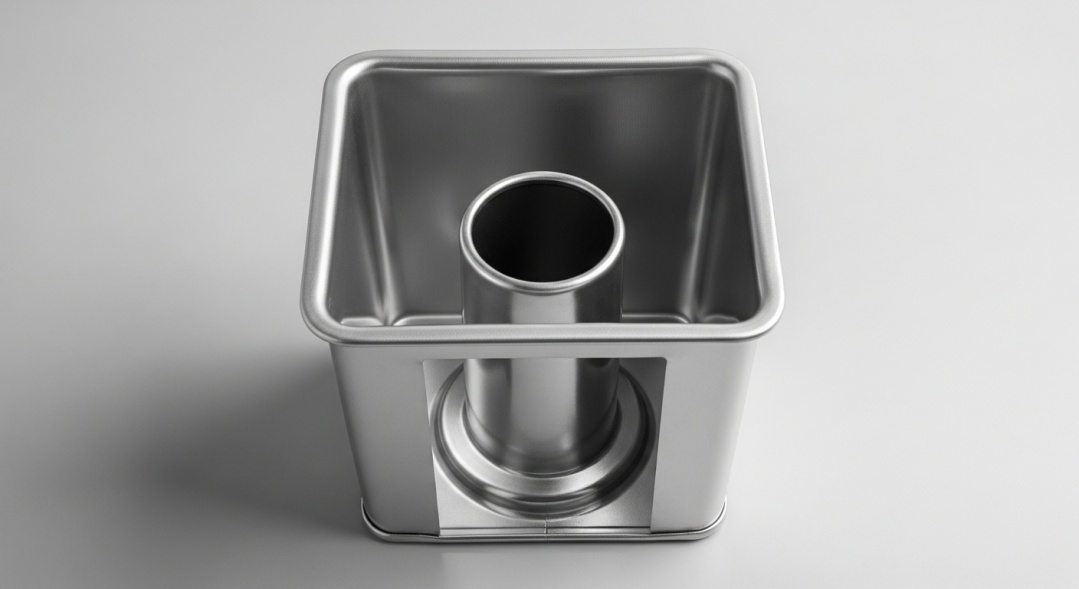
The sides aren't smooth like a tube pan—they're full of curves, grooves, and decorative details. Some have simple ridges, while others look like works of art with elaborate designs. I have three different Bundt pans now (yes, I have a problem), and each one creates a completely different look.
Unlike tube pans, Bundt pans have a fixed bottom. The batter goes in, the cake bakes, and then you flip the whole thing over to release it. There's no removable bottom to help you out, which means greasing and flouring this pan properly is absolutely critical. I learned this the hard way when half of my first lemon pound cake stayed stuck in the pan.
Bundt pans are perfect for dense, sturdy cakes—think pound cakes, coffee cakes, rum cakes, and butter cakes. These are cakes with enough structure to hold themselves up and support all those beautiful details. The name "Bundt" is actually a trademark of Nordic Ware, the company that popularized these pans back in the 1950s, though we tend to use it generically now.
I reach for my Bundt pan whenever I want a cake that looks impressive with minimal effort. No frosting required—just a simple glaze or dusting of powdered sugar, and you've got a showstopper.
What is an Angel Food Cake Pan?
Here's where things get a little less confusing: an angel food cake pan is actually just a specific type of tube pan. When someone says "angel food cake pan," they're referring to a tube pan that's specifically designed for making angel food cake.
So why the different name? Well, not all tube pans are ideal for angel food cake, and this is where the details matter.
A proper angel food cake pan has a few non-negotiable features. First, it absolutely must have a removable bottom. Angel food cake has such a delicate, airy texture that you need to be able to gently push the cake up and out of the pan. Trying to flip it would be a disaster—I know because I've seen the aftermath when my friend tried it.
Second, the interior needs to be completely smooth and uncoated. Angel food cake batter is so light and fluffy that it needs to cling to the pan sides as it rises. If the pan is nonstick or coated, the batter will slide back down and you'll end up with a dense, short cake instead of a tall, fluffy one.
Third, and this is crucial, it needs those feet or a raised edge I mentioned earlier. Angel food cakes must cool upside down to prevent them from collapsing as they cool. The feet allow air to circulate while keeping your beautiful cake suspended.
I bought a dedicated angel food cake pan after my Bundt pan disaster, and it was worth every penny. Now when I make angel food cake, it comes out tall, fluffy, and perfect every time.
Is a Fluted Pan the Same as a Bundt Pan?
Short answer: yes, they're the same thing.
When you hear someone talking about a "fluted pan," they're just using a descriptive term for a Bundt pan. "Fluted" refers to those decorative grooves and ridges that make Bundt cakes so pretty. It's like saying "sedan" versus "car"—one is just more specific than the other.
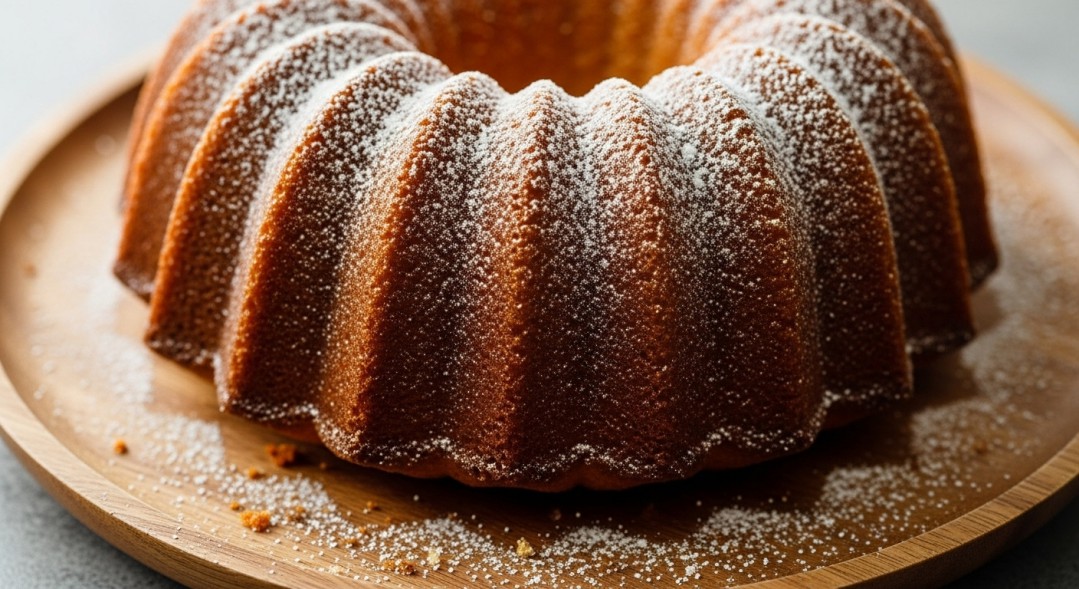
I've noticed that older recipes and European baking books tend to use "fluted tube pan" instead of "Bundt pan," probably because Bundt is a brand name. But in everyday American baking conversations, we almost always say Bundt pan, and everyone knows what you mean.
The fluting is what creates all those gorgeous patterns when you unmold your cake. Each ridge and curve shows up as a defined line or shape on your finished cake. Some of my favorite moments in baking come from that reveal when you lift the pan and see how perfectly all those details transferred.
One thing to note: not every fluted tube pan is officially a "Bundt" pan since that's Nordic Ware's trademark. But functionally, any fluted tube pan with a fixed bottom works the same way. I have one off-brand fluted pan that works just as well as my official Bundt.
Key Differences: Bundt Pan vs Tube Pan
Let me break down the real differences between these pans, because this is where understanding the details will save you from ruined cakes and wasted ingredients.
The Interior Design
This is the most obvious difference, and it's huge. My tube pan has smooth, plain sides—nothing fancy, just straight walls. My Bundt pan looks like someone carved an art piece—all those swirls, ridges, and decorative patterns.
Why does this matter? The smooth sides of a tube pan allow delicate batters to grip and climb as they bake. Those cakes need traction. The fluted design of a Bundt pan is perfect for sturdy batters that can hold their shape and show off all those pretty details.
The Bottom Situation
My tube pan has a removable bottom that lifts right out. This has saved me countless times when dealing with fragile cakes. I can push the entire cake up and out, then carefully slide it off the bottom piece.
My Bundt pan's bottom is fixed—it's all one piece. Once the cake is baked, I flip the whole pan over onto a cooling rack or plate and pray that I greased it well enough. There's always that moment of suspense before I lift the pan, wondering if the cake will come out cleanly or if I'll be scraping pieces out with a spatula.
What They're Best For
I've learned through experience (and failures) that each pan has its strengths. My tube pan is the only option for angel food cakes, chiffon cakes, and sponge cakes—anything with a light, airy texture that needs to cling to the pan sides.
My Bundt pan is my go-to for pound cakes, coffee cakes, rum cakes, and any dense batter that can support itself. These cakes have enough butter, eggs, and structure to hold up those decorative shapes.
Greasing Requirements
This is where I made some early mistakes. For my tube pan, especially when making angel food cake, I don't grease it at all. The batter needs to stick to those smooth sides to rise properly. Grease would make it slide right back down.
For my Bundt pan, I go overboard with the greasing. I use a baking spray with flour in it, and I make sure to get into every single groove and crevice. Miss one spot, and that's exactly where your cake will stick. I've also had great success with the old-fashioned method of butter and flour, taking time to brush into every detail.
The Cooling Process
With my tube pan, I flip the cake upside down immediately after baking and let it hang there until it's completely cool. Those little feet hold it up perfectly.
With my Bundt pan, I let the cake cool in the pan for about 10-15 minutes (check your specific recipe), then flip it onto a rack. If I wait too long, the cake sweats and sticks. If I flip it too soon, it might fall apart. Timing is everything.
Can You Substitute a Bundt Pan for a Tube Pan?
This is the million-dollar question, and I wish someone had given me a clear answer before my angel food cake catastrophe.
For Angel Food Cake: Absolutely Not
I cannot stress this enough: do not try to make angel food cake in a Bundt pan. Just don't. I tried it, and here's what happened:
The batter couldn't grip those fluted sides, so it didn't rise properly. The cake came out short and dense instead of tall and fluffy. When I tried to cool it upside down, the cake partially fell out onto my counter because there was no removable bottom to support it. And even if I'd left it right-side up, it would have collapsed from its own weight while cooling.
The whole thing was a disaster. I ended up with something that looked more like a sad, deflated tire than a cloud-like dessert. Save yourself the heartbreak and the wasted ingredients—if a recipe calls for a tube pan and you're making angel food or chiffon cake, you really do need an actual tube pan.
For Other Recipes: Proceed with Caution
Now, can you use a Bundt pan when a recipe calls for a tube pan but it's not for an angel food cake? Sometimes, yes, but you need to make adjustments.
I've successfully used my Bundt pan for recipes that originally called for a tube pan when the batter was dense enough—things like certain coffee cakes or dense butter cakes. But here's what you need to know:
You absolutely must grease and flour your Bundt pan thoroughly. I can't emphasize this enough. Every groove, every ridge, every tiny detail needs to be coated. I use a pastry brush to make sure I get into all the crevices.
Your baking time might be slightly different. The fluted design of a Bundt pan creates more surface area, which can affect how quickly the cake bakes. I usually start checking for doneness about 5 minutes earlier than the recipe suggests.
You can't cool the cake upside down in the same way. Instead, I cool it in the pan for 10-15 minutes, then flip it onto a cooling rack. The cake needs to be sturdy enough to handle this.
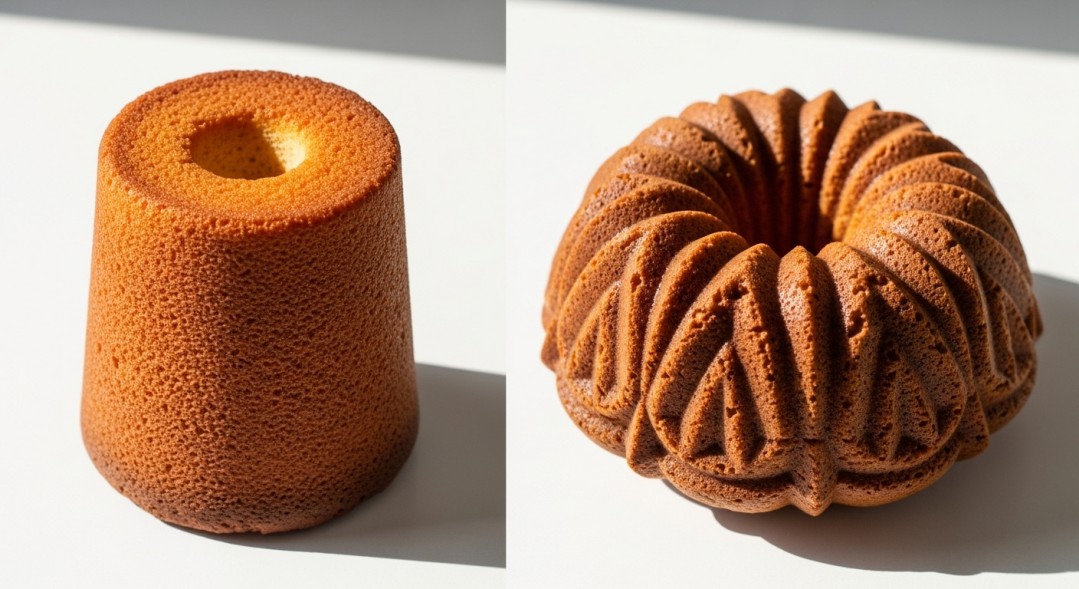
The appearance will be completely different. Instead of a plain, simple cake, you'll have one with decorative ridges. This isn't necessarily a bad thing—it might actually look fancier! But if you're making the cake for a specific occasion and the plain look matters, keep that in mind.
Can You Substitute a Tube Pan for a Bundt Pan?
The good news is that this swap usually works much better than going the other direction.
I've used my tube pan when recipes called for a Bundt pan more times than I can count, especially when I want to make a pound cake but want a simpler presentation. It works beautifully for dense batters like pound cakes, coffee cakes, and butter cakes.
The main thing you'll sacrifice is the gorgeous decorative appearance. Your cake will come out with smooth, plain sides instead of those fancy swirls and ridges. It'll taste exactly the same, but it won't have that showstopping visual appeal.
Here's what I do to make this substitution work:
Even though tube pans are generally easier to release from, I still grease and flour mine lightly when using it for denser batters. These aren't delicate angel food cakes that need to grip the sides, so a little grease is helpful.
The removable bottom makes getting your cake out incredibly easy. Just let it cool, run a knife around the edges, push up the bottom, and slide the cake off. No nerve-wracking flipping required.
Since the smooth sides don't create as much surface area as fluted ones, your cake might take slightly longer to bake. I usually add a few minutes and test with a toothpick or cake tester.
The cooling process is straightforward—just let it cool in the pan for a bit, then remove it. No need to flip it upside down unless you're making one of those specific cakes that requires it.
I actually prefer using my tube pan for pound cakes when I'm planning to glaze them heavily or add fresh fruit on top. The simpler shape makes a better canvas for toppings and decorations.
Which Pan Should You Buy?
If you're standing in a store or scrolling through Amazon right now, trying to decide which pan to add to your collection, let me share what I wish someone had told me.
If You're an Occasional Baker
Start with a good-quality Bundt pan. This was my first purchase, and I don't regret it. A Bundt pan is more versatile for everyday baking—you can make pound cakes, coffee cakes, monkey bread, even savory dishes. It makes any cake look special without requiring fancy decorating skills, which is perfect when you're bringing dessert to a potluck or hosting dinner guests.
Look for one that's 10 or 12 cups, which handles most standard recipes. I recommend getting one with a good nonstick coating or, even better, a cast aluminum pan. My Nordic Ware Bundt pan was more expensive than the cheaper alternatives, but it's been worth every penny. The cakes release cleanly, it heats evenly, and it's still going strong after years of use.
If You Love Angel Food Cake
Then you absolutely need a tube pan with a removable bottom. There's no way around this one. I resisted buying one for way too long because I thought I could make do with what I had, but once I finally invested in a proper angel food cake pan, my success rate went from about 30% to nearly 100%.
Look for one that's 10 inches, which is the standard size. Make sure it has those feet or a raised rim for cooling upside down. Don't get a nonstick version—you want uncoated aluminum so the batter can grip the sides.
If You're a Serious Baker
Get both. I know it sounds excessive, but they really do serve different purposes. I use both of mine regularly, and neither one can truly replace the other.
My tube pan gets pulled out for angel food cakes, chiffon cakes, and occasionally for pound cakes when I want a simpler look. My Bundt pan is for everything else—those rich, buttery cakes that benefit from a decorative shape.
If your budget allows, I'd even suggest getting multiple Bundt pans in different designs. Each pattern creates a unique look, and it's fun to match the pan to the occasion. My cathedral Bundt pan comes out for holidays, my classic swirl for everyday cakes, and my rose-shaped one for special occasions.
Quality Features to Look For
After buying several pans over the years (some great, some not so great), here's what I've learned to look for:
Heavy-gauge metal that won't warp in the oven. I had a cheap Bundt pan that started bending after a few uses, and my cakes baked unevenly after that.
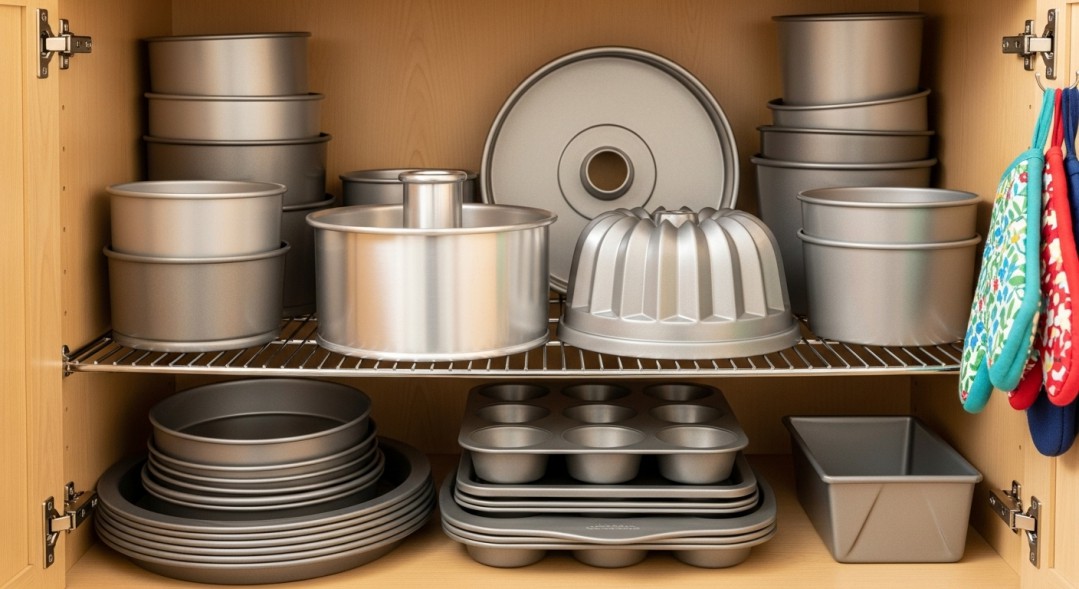
Good nonstick coating or quality bare aluminum. Both work, but they require different care. My nonstick pans are easier to clean, but my bare aluminum tube pan is better for angel food cakes.
Solid construction with no seams where batter could leak. I once had a pan with a seam at the bottom that leaked batter all over my oven. Never again.
Comfortable handles or grips. When you're flipping a hot pan full of cake, you want to feel secure.
Quick Reference Guide
Let me give you the cheat sheet I wish I'd had when I first started baking with these pans.
Use a tube pan when you're making angel food cake, chiffon cake, or sponge cake. These are light, airy cakes with delicate textures that need to grip smooth pan sides to rise properly. If your recipe specifically says the batter needs to cling to the pan, you need a tube pan.
Use a Bundt pan when you're making pound cake, coffee cake, rum cake, or any dense butter cake. These sturdy batters can support themselves and will showcase all those beautiful decorative details. If you want a cake that looks impressive without frosting, reach for your Bundt pan.
You can't substitute when making angel food cake or chiffon cake. These recipes absolutely require a proper tube pan with a removable bottom and smooth sides. No exceptions, no shortcuts. Trust me on this one.
You can substitute when making dense cakes like pound cakes or coffee cakes. Either pan will work, though you'll get different appearances. Use a tube pan for a simple look, a Bundt pan for decorative flair. Just adjust your greasing method and keep an eye on baking times.
Common Mistakes to Avoid
I've made pretty much every mistake possible with these pans, so let me save you some trouble.
Using the Wrong Pan for Angel Food Cake
I've already told you about my disaster, but I'll say it again: don't try to make angel food cake in a Bundt pan. And don't try it in a regular tube pan that's nonstick or has a fixed bottom. You need that specific combination of smooth sides, removable bottom, and uncoated surface. Anything else is setting yourself up for disappointment.
Not Greasing Bundt Pans Properly
This is probably the most common mistake I see, and I've done it myself too many times. You cannot just give your Bundt pan a quick spray and call it good. You need to get into every single groove, every ridge, every tiny crevice.
I now use either a nonstick baking spray with flour, or I brush melted butter into all the details and then dust with flour, tapping out the excess. It takes an extra few minutes, but it's worth it when your cake slides out in one perfect piece.
On the flip side, I've seen people grease their tube pans when making angel food cake. Don't do this! The batter needs to stick to the sides to rise. Greasing it will cause your cake to collapse.
Cooling Cakes Incorrectly
Angel food and chiffon cakes must cool upside down. If you try to cool them right-side up, they'll collapse under their own weight while they're still warm. Those little feet on your tube pan aren't decorative—they're functional. Use them.
For Bundt cakes, timing is everything. I've ruined cakes by leaving them in the pan too long (they steam and stick) and by trying to remove them too soon (they fall apart). Most recipes say 10-15 minutes, and that's usually about right. The cake should be set but still slightly warm when you flip it out.
Forcing Substitutions That Won't Work
I get it—sometimes you don't have the exact pan a recipe calls for, and you want to make it work. But some substitutions are just doomed from the start. If you're making angel food cake and don't have a proper tube pan, I'd honestly recommend choosing a different recipe rather than trying to make it work with a Bundt pan. Some things are worth buying the right equipment for.
Not Testing for Doneness Properly
The tube in the middle of these pans means the batter is distributed in a ring shape, which can bake differently than a regular cake. I've had cakes that looked done on the outside but were still raw near the tube.
Always test in multiple spots—near the outer edge, in the middle, and near the inner tube. A toothpick or cake tester should come out clean or with just a few moist crumbs. If you're getting wet batter, keep baking, even if the timer says it should be done.
Wrapping It All Up
After years of baking with both tube pans and Bundt pans, I can tell you they're both valuable tools, but they're definitely not the same thing. Understanding the differences has made me a much better baker and has saved me from countless disasters.
The key takeaway is this: tube pans and Bundt pans might look similar because they both have that center tube, but they're designed for completely different types of cakes. Tube pans are for light, delicate cakes that need smooth sides to climb and a removable bottom for easy removal. Bundt pans are for sturdy, dense cakes that can handle decorative fluting and need serious greasing to release cleanly.
Can you sometimes swap one for the other? Sure, if you're working with the right kind of batter and you understand what adjustments to make. But should you try to make angel food cake in a Bundt pan? Absolutely not. Learn from my mistakes on that one.
If you're just starting to build your baking pan collection, I'd say get a good Bundt pan first—it's more versatile for everyday baking and makes your cakes look professional with minimal effort. But if you love light, airy cakes, invest in a proper tube pan with a removable bottom. And if you're serious about baking, eventually get both. They each have their place in the kitchen.
The most important thing is to use the right pan for the right job. Your cakes will turn out better, you'll waste fewer ingredients, and you'll save yourself the frustration of dealing with stuck or collapsed cakes.
Now if you'll excuse me, I have an angel food cake cooling upside down in my tube pan, and there's a lemon pound cake in my Bundt pan in the oven. The kitchen smells amazing, and I'm feeling pretty confident that both will turn out perfectly. That's the power of using the right pan for the job.
Leave a Reply